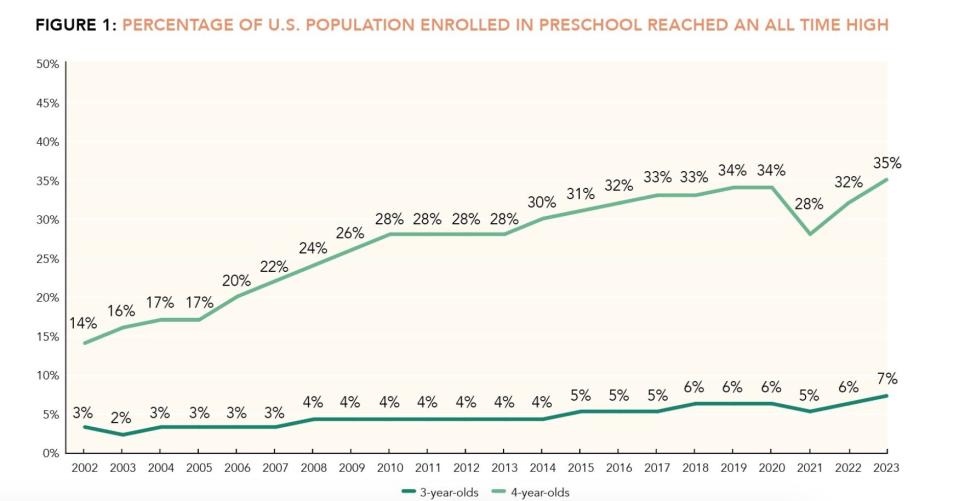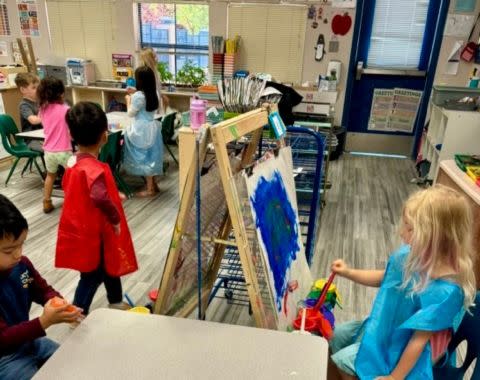Four-year-olds attending elementary school in Mississippi’s Lamar County Schools don’t spend their days with worksheets or hunched over papers practicing their letters. But they do have plenty of books, Play-Doh and time for friends.
And some go to kindergarten knowing how to read.
“But that’s not because we’re chasing them,” said Heather Lyons, coordinator of the program. “It’s because we’re constantly trying to help them pursue this love of learning.”
Pre-K enrollment nears comeback from pandemic amid push for universal access
Get stories like this straight to your inbox. Sign up for the 74 newsletter
That careful mix of academic and social skills is one of the reasons why the program is in high demand. Parents start calling in January to ask if their children should be enrolled for the fall, Lyons said. Lamar’s program is part of Mississippi First, a statewide pre-K initiative that now serves a quarter of the state’s four-year-olds — up from about 3% six years ago.
According to the National Institute for Early Education Research’s recent State of Preschool Yearbook, the state helped boost pre-K enrollment nationwide to record levels in 2022-2023. After a sharp decline during the pandemic, kindergarten enrollment is on the rise again. Last school year, more than 1.6 million children attended public preschool, with the percentage of 3- and 4-year-olds reaching new highs.
Expanding access, however, does not mean states should cut back on quality by lowering teacher training requirements or increasing class sizes, the report’s authors note.

They point to Mississippi as an example of a state that has managed to increase enrollment while maintaining high standards.
In fact, the state is among the few that have codified the institute’s “quality benchmarks” into law. These include having teachers with bachelor’s degrees, assistants with early childhood training, and screenings for vision, hearing and health problems.
“We’re keeping an eye on them,” said Allison Friedman-Krauss, an assistant research professor at the institute. “They started small with a focus on quality. They are also working hard to fund more coaches to support teachers, so they are committed to quality in that way.”


There are now 36 early learning partnerships – local partnerships that include school districts, Head Start providers and child care centers – offering the pre-K program.
“We are moving out of the baby phase and into the teen phase of the law,” said Rachel Canter, executive director of the program. She added that the inclusion of Head Start, the federal preschool program for children in poverty, is one of the reasons why Mississippi First receives bipartisan support. “People across the political spectrum are seeing how it can benefit their own communities. That has allowed us to expand it statewide while ensuring children who need it most have access.”
Thanks in part to her advocacy, the Legislature has increased annual spending on the program five times since 2016.
The challenge now is to increase and continue to expand the number of participating child care providers, she said.
In communities without a program, parents are often left with lower-quality options or having to juggle their child between multiple caregivers during the day. Other parents, Canter said, would need fewer hours at work to stay home with their children. “That’s a terrible situation for a working family.”
Supporting the workforce
Advocates and policymakers are often the forces behind efforts to expand early childhood education. But in New Mexico — another state making big strides in the pre-K era — it was voters who demanded greater access when they overwhelmingly approved a 2022 ballot initiative by a 73% majority.
The law creates permanent funding for early learning, which led to the Legislature appropriating $100 million for preschool last year. School districts, child care providers and tribal governments are now using some of these funds to strengthen the program by increasing teacher salaries to match what K-12 teachers receive, using high-quality curriculum and to give preschoolers a longer school day.
The state also provides grants to teachers who are still graduating and pays for substitutes so teachers can take time off to take courses.
“The early childhood workforce has historically been undervalued,” said Sara Mickelson, deputy secretary of the Department of Education and Early Childhood Care. “We are truly a state that supports access to degrees.”
Meanwhile, 70% of four-year-olds in New Mexico now attend public preschool, making the state one of the few to serve at least two-thirds of eligible students.
But states that serve the most preschoolers — such as California, Florida and Texas — are not always examples of high quality.
Results from a long-term study in support of Universal Pre-K
California has spent more than $830 million on preschool through 2022-2023 and is on track to make all four-year-olds eligible for the kindergarten transition program by fall 2025. That figure was responsible for more than 70% of the total $1.17 billion increase in spending on children. nationwide, says Steve Barnett, senior co-director of the institute.
But since its inception a decade ago, the transition program has met only a few of the institute’s 10 quality indicators. Teachers did not have to undergo special training in teaching young children and class sizes were much larger than recommended: as many as 33 students, compared to the institute’s benchmark of 20.
“There were no guidelines from the state,” said Rahele Arakabi, director of educational services for the Washington Unified School District in West Sacramento. Classrooms, she said, looked more like first grade than kindergarten, with students sitting in rows facing the whiteboard. “Teachers were really in that drill-and-kill mode.”
But the prospects for the program have improved. Statewide, class sizes are now limited to 24 students with two teachers; districts and charters that do not comply face fines. By the 2025-2026 school year, the ratios will be set to the institute’s standard of 10 to 1. The state is also offering a new credential for teachers who teach kindergarten through third grade, and by next year teachers should be required to have a college degree or experience in early childhood education.
In Washington Unified, which serves 130 kindergarten students in six grades, the ratios are even lower: 8 to 1. Some teachers who worked in the district’s separate preschool program have already been certified to teach transitional kindergarten.


Arakabi used a $400,000 state grant to make classrooms more child-friendly, with age-appropriate furniture and play areas. She implemented a new curriculum specifically for pre-K and provided coaching and child development support for a year. She believes the investment makes a difference.
“My concern was always that I would buy a curriculum and then it would just sit there in the shrink wrap,” she said. “This group of teachers is not easy to please, but they actually take advantage of it.”







